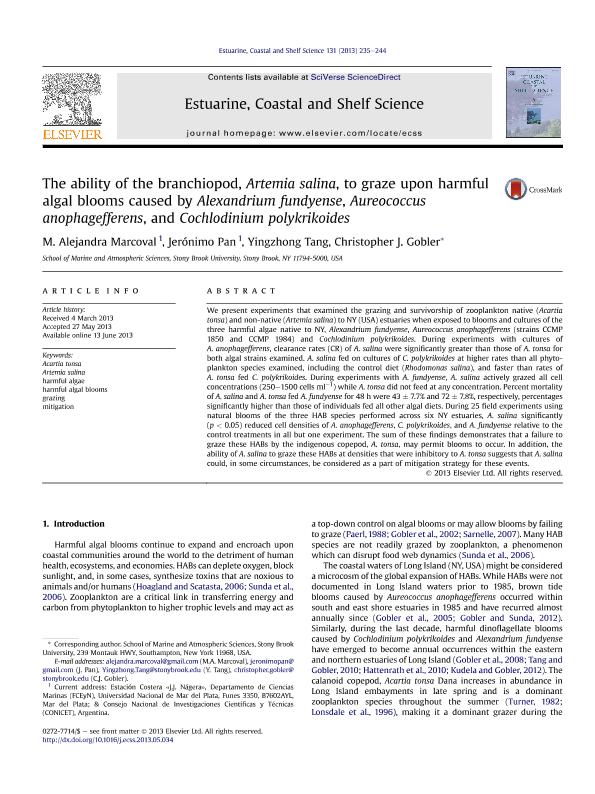Artículo
The ability of the branchiopod, Artemia salina, to graze upon harmful algal blooms caused by Alexandrium fundyense, Aureococcus anophagefferens, and Cochlodinium polykrikoides
Fecha de publicación:
06/2013
Editorial:
Academic Press Ltd-elsevier Science Ltd
Revista:
Estuarine, Coastal and Shelf Science
ISSN:
0272-7714
e-ISSN:
1096-0015
Idioma:
Inglés
Tipo de recurso:
Artículo publicado
Clasificación temática:
Resumen
We present experiments that examined the grazing and survivorship of zooplankton native (Acartia tonsa) and non-native (Artemia salina) to NY (USA) estuaries when exposed to blooms and cultures of the three harmful algae native to NY, Alexandrium fundyense, Aureococcus anophagefferens (strains CCMP 1850 and CCMP 1984) and Cochlodinium polykrikoides. During experiments with cultures of A. anophagefferens, clearance rates (CR) of A. salina were significantly greater than those of A. tonsa for both algal strains examined. A. salina fed on cultures of C. polykrikoides at higher rates than all phytoplankton species examined, including the control diet (Rhodomonas salina), and faster than rates of A. tonsa fed C. polykrikoides. During experiments with A. fundyense, A. salina actively grazed all cell concentrations (250–1500 cells ml−1) while A. tonsa did not feed at any concentration. Percent mortality of A. salina and A. tonsa fed A. fundyense for 48 h were 43 ± 7.7% and 72 ± 7.8%, respectively, percentages significantly higher than those of individuals fed all other algal diets. During 25 field experiments using natural blooms of the three HAB species performed across six NY estuaries, A. salina significantly (p < 0.05) reduced cell densities of A. anophagefferens, C. polykrikoides, and A. fundyense relative to the control treatments in all but one experiment. The sum of these findings demonstrates that a failure to graze these HABs by the indigenous copepod, A. tonsa, may permit blooms to occur. In addition, the ability of A. salina to graze these HABs at densities that were inhibitory to A. tonsa suggests that A. salina could, in some circumstances, be considered as a part of mitigation strategy for these events.
Archivos asociados
Licencia
Identificadores
Colecciones
Articulos(CCT - MAR DEL PLATA)
Articulos de CTRO.CIENTIFICO TECNOL.CONICET - MAR DEL PLATA
Articulos de CTRO.CIENTIFICO TECNOL.CONICET - MAR DEL PLATA
Citación
Marcoval, Maria Alejandra; Pan, Jerónimo; Tang, Yingzhong; Gobler, Christopher J.; The ability of the branchiopod, Artemia salina, to graze upon harmful algal blooms caused by Alexandrium fundyense, Aureococcus anophagefferens, and Cochlodinium polykrikoides; Academic Press Ltd-elsevier Science Ltd; Estuarine, Coastal and Shelf Science; 131; 6-2013; 235-244
Compartir
Altmétricas




